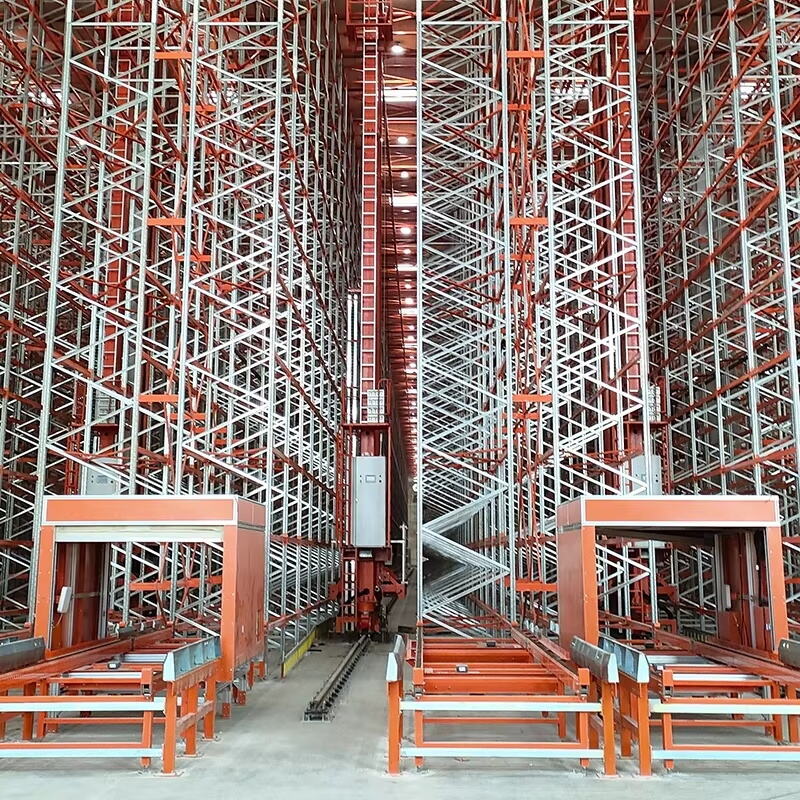The Evolving Landscape of ASRS Warehousing Automation
From Manual Systems to Intelligent Automation
Warehouses have come a long way since the days of purely manual operations when workers had to physically move goods around all day. Back then, finding items meant walking through rows upon rows of inventory, often leading to misplaced stock or damaged products during handling. With the advent of automated storage and retrieval systems (ASRS), things changed dramatically. These systems use computer controlled machinery to handle everything from placing items on shelves to retrieving them when needed. A study published last year showed that companies implementing ASRS typically save around 30% on their labor expenses compared to traditional methods. This makes sense when we consider how much time warehouse staff used to spend just searching for products instead of actually processing orders.
Automated Storage and Retrieval Systems consist of several main parts that have become essential in today's logistics operations. The different types include things like unit load cranes, mini load systems, vertical lift modules, and shuttle systems, all designed for particular kinds of storage requirements. What makes ASRS so useful is their combination of sophisticated software along with robotic technology, which speeds up retrieval times and makes better use of available space. Take vertical lift modules for example they work great when companies need to make the most out of limited floor area. Shuttle systems on the other hand tend to perform really well in areas where there's just tons of inventory packed closely together. With businesses constantly looking for ways to streamline their supply chains, we're seeing more warehouses invest in these automated solutions year after year.
AI & Machine Learning Revolutionizing Inventory Management
Predictive Analytics for Stock Optimization
Inventory management is changing fast thanks to predictive analytics which looks at past sales numbers to figure out what customers might want next. When companies start using these smart algorithms, they get a much better picture of how people shop, what happens during different seasons, and when demand goes up or down unexpectedly. Take some retailers who implemented AI based prediction systems for their warehouses last year - many saw around 20 percent better results in managing their stock levels. The real value comes from knowing when too much product sits on shelves versus when shelves are empty. With good predictions, businesses avoid wasting money on excess inventory while still keeping products available when customers need them most. These forecasting tools help strike that delicate balance between having enough stock without tying up capital unnecessarily, all while making sure shoppers don't walk away frustrated because something they wanted wasn't there.
Machine Learning in Demand Forecasting
Machine learning has become pretty important for making demand forecasts much more accurate than old school methods ever could. Companies that actually implement these tech solutions often see their predictions get better somewhere between 15% and 30%. That kind of boost gives them real advantages when competing against others in their field. The models themselves come in different forms like time series analysis or those fancy neural network setups. What makes them work so well is their ability to continuously learn from past data while adapting to new information as it comes in. Take ASRS warehouses for instance. Here, machine learning helps figure out what stock levels will probably be needed next month or quarter. This then connects directly with the warehouse's automation systems, which means operations run smoother and faster responses happen whenever market conditions suddenly shift.
IoT Integration: Creating Smart Warehouse Ecosystems
Real-Time Equipment Monitoring Solutions
Bringing IoT into warehouse operations makes it much easier to keep track of how equipment is performing day to day, which helps run things more smoothly overall. The sensors attached to machines give constant updates on their status, cutting down on unexpected stoppages quite a bit. Some warehouses report around 25% less time lost when machines break down because these systems warn them ahead of time. When something starts acting funny, workers get notifications right away so they can fix minor problems before they turn into major headaches. This means forklifts stay running instead of sitting idle in corners waiting for someone to notice something's wrong. Most warehouse managers find that keeping an eye on these metrics through dashboards actually changes how teams approach maintenance tasks across the board.
Connected Inventory Tracking Networks
The Internet of Things has made it possible to build these smart networks for tracking inventory in real time, completely changing how warehouses operate day to day. Companies that have started using IoT in their stock management report better results across the board. For instance, one major retailer saw inventory count accuracy jump by 30% after implementation. When products, pallets, and storage racks get connected through IoT sensors, inventory information gets updated instantly. This cuts down on errors and makes operations run smoother overall. What's really interesting is how this connectivity lets businesses follow each item all the way through the supply chain while making security tighter at every step. Goods stay safer from when they first arrive at the warehouse right through to delivery to customers.
Advanced Robotics: The New Workforce
Next-Generation AGVs with AI Navigation
Autonomous Guided Vehicles or AGVs are changing how warehouses work, especially since they now incorporate artificial intelligence for better movement around facilities. These smart vehicles actually analyze information from their surroundings and figure out the best paths to take, making everything run smoother when it comes to getting tasks done. Warehouses that have adopted AGVs report real gains too - some see picking speeds jump by roughly 40%, which means products move through the system much quicker than before. Companies like Daifuku and SSI SCHAEFER stand out in this space because they've been developing cutting edge AGV systems for years. Their machines aren't just moving boxes around anymore either. They're integrated into automated storage retrieval systems that handle inventory management while reducing labor costs. As e-commerce continues growing at breakneck speed, we'll likely see even more warehouses adopting these intelligent transport solutions to keep up with customer expectations.
Collaborative Robotic Systems
Warehouse operations are changing fast thanks to collaborative robots, commonly called cobots, which work right beside human staff to boost both productivity and workplace safety. These machines take care of those boring, repetitive jobs that people used to do all day long, freeing up workers for tasks that require actual thinking and problem solving. Industry data suggests warehouse productivity jumps anywhere from 30% to 50% once cobots come onboard. What makes these robots so special? They have smart sensors and clever programming that lets them stop immediately if someone gets too close, meeting strict safety standards like ISO/TS 15066 along the way. Warehouses adopting cobots typically see better bottom line results while keeping their employees safer at the same time. With technology advancing so rapidly and regulations getting tighter, it's no surprise that more and more facilities are looking seriously at bringing cobots into their daily operations.
Energy-Efficient ASRS Solutions
Renewable Energy Integration Strategies
Making ASRS systems more energy efficient often means looking at new ways to bring renewable power into warehouse operations. Many storage facilities are finding real value in these green initiatives as they work toward meeting their environmental targets. Take for example several distribution centers that now cover around 70 percent of their electricity needs using solar arrays and small wind turbines installed on site. Switching to clean energy sources has cut down greenhouse gas emissions considerably for these operations, plus it helps them stay within regulatory limits set by local authorities. Some managers report initial costs can be high but long term savings make the investment worthwhile despite the upfront expense.
Lower carbon emissions fit right into what's happening across industries regarding green supply chains these days. Both government rules and what customers want are pushing companies toward cleaner approaches. When businesses adopt these greener methods, they cut down on environmental damage while often saving money too since they need less traditional power. For many manufacturers, this isn't just about checking boxes for today's laws it's building something that will work when energy regulations inevitably change again. Take warehouses using ASRS systems for instance. By switching to solar panels or wind power at their facilities, these operations stay ahead of the curve in sustainable logistics while still keeping costs under control.
5G-Powered Warehousing Operations
Ultra-Reliable Low Latency Communication
The introduction of 5G tech has transformed how machines talk to each other inside warehouses. With its super reliable connection and minimal lag time, data moves between devices so fast it feels like magic, making automated systems work much better than before. Warehouse managers love seeing the numbers drop when looking at latency stats these days. We're talking milliseconds instead of seconds now, which makes all the difference when things need to happen right this minute. The faster information travels through the network, the smoother everything runs from inventory tracking to robotic arms picking items off shelves. Some facilities report cutting down on errors by over 30% since switching to this new connectivity standard.
Bringing 5G into warehouse operations opens up exciting possibilities for advances in automated storage and retrieval systems (ASRS). The fast data transfer speeds enabled by 5G networks allow these systems to work with much greater accuracy when handling goods. Warehouses that adopt this technology see better synchronization between their robotic arms and inventory tracking software. This means fewer delays during peak times, workers spending less time fixing errors, and customers getting exactly what they ordered without mistakes. Looking ahead, as warehouses keep transforming to meet modern demands, 5G connectivity stands out as one of those game changers that could completely reshape how we think about storing and moving products around.
To wrap things up, bringing 5G into smart warehouses really changes the game for ASRS systems going forward. When warehouses get that fast communication between devices, they can actually start using those fancy AI tools and IoT sensors we keep hearing about. Think about it this way: with millisecond response times, automated storage systems can react instantly to inventory changes, reducing errors and downtime. Some early adopters have already seen productivity jumps of around 30% just from implementing basic 5G connectivity. The material handling industry is definitely moving toward this kind of real-time responsiveness, and companies that jump on board now will likely stay ahead of the competition for years to come.
FAQ
What are the benefits of Automated Storage and Retrieval Systems (ASRS)?
ASRS offer benefits such as reduced labor costs, increased retrieval speed, enhanced space utilization, and improved efficiency and accuracy in storage and retrieval operations.
How does predictive analytics improve inventory management?
Predictive analytics enhances inventory management by using historical sales data to anticipate future demand, thus optimizing stock levels, minimizing overstock and stockouts, and improving the supply chain's overall efficiency.
What role does IoT play in warehousing?
IoT is crucial in warehousing as it enables real-time equipment monitoring, connected inventory tracking, and improved accuracy and transparency throughout the supply chain.
How do collaborative robots (cobots) impact warehouse productivity?
Collaborative robots boost productivity by performing repetitive tasks, allowing human workers to focus on complex activities. Cobots enhance efficiency and create a safer work environment.
What advantages does 5G technology bring to warehousing operations?
5G technology provides ultra-reliable low latency communication, allowing for instantaneous data transmission and enhanced coordination of robotic and inventory systems, leading to improved efficiency and accuracy.

